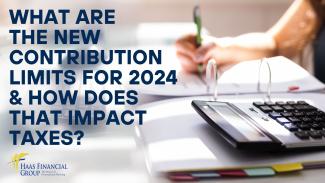
What Are the New Contribution Limits For 2024 & How Does That Impact Taxes?
A new year means some increased amounts for saving into retirement and healthcare accounts! Here’s a quick rundown of some updates for retirement savings:
- 401(k) contribution for people under age 50: $23,000 (up from $22,500 in 2023)
- 401(k) catch-up contribution for people age 50 and older: unchanged at $7,500 (total of $30,500 to your 401(k) if over age 50)
- SIMPLE IRA’s: $16,000 (up from $15,500 in 2023)
- IRA’s & Roth IRA’s: $7,000 (up from $6,500 in 2023)
- $7,000/year for people under age 50
- $1,000 catch-up for people age 50 and older (total of $8,000/year)
- HSA contributions:
- Single coverage: $4,150 (up from $3,850 in 2023)
- Family coverage: $8,300 (up from $7,750 in 2023)
- Catch-up contribution for people age 55+: $1,000
Why is it important to consider these numbers? Because many savers do so systematically. If you set your employee contributions to a certain percentage of pay, take the time to recalculate the appropriate amount for 2024 (savings goal divided by contribution periods as an example). The beginning of the year offers a great opportunity to reset your goals and increase savings where eligible.
Curious what type of savings you are eligible to do? As shown above, age is one factor. But your ability to save may also depend on your annual earnings and whether or not you (or your spouse) have a workplace plan available to them. Here’s a list of the updated IRA and Roth IRA income eligibility limits for 2024:
Traditional IRA income phase-out ranges for the deductibility of contributions:
- $77,000 to $87,000 - Single taxpayers covered by a workplace retirement plan
- $123,000 to $143,000 - Married couples filing jointly. This applies when the spouse making the IRA contribution is covered by a workplace retirement plan.
- $230,000 to $240,000 - A taxpayer not covered by a workplace retirement plan married to someone who's covered.
- $0 to $10,000 – Married filing a separate return. This applies to taxpayers covered by a workplace retirement plan
Roth IRA contributions income phase-out ranges:
- $146,000 to $161,000 - Single taxpayers and heads of household
- $230,000 to $240,000 - Married, filing jointly
- $0 to $10,000 - Married, filing separately
Overall, these increases will help people save a little more into their retirement accounts and help lower their taxable income if they save into a pre-tax plan. One important detail to note is that if you typically choose to contribute the maximum to your employer retirement plan or IRA, you may have to recalculate your contribution percentage based on the updated amounts above to ensure you will maximize your contributions in 2024. If you have any questions about this information or if the phaseout-ranges could apply to you, give us a call and we’d be happy to help!
Sources:
Investment advice offered through Great Valley Advisor Group, a Registered Investment Advisor. Great Valley Advisor Group and Haas Financial Group are separate entities. This is not intended to be used as tax or legal advice. Please consult a tax or legal professional for specific information and advice.
Tracking # T006570

